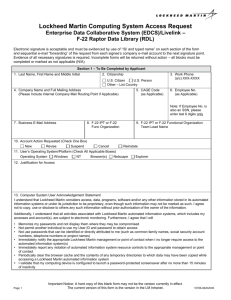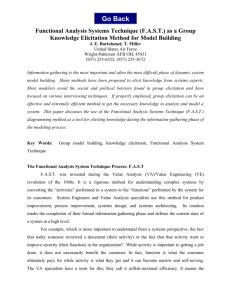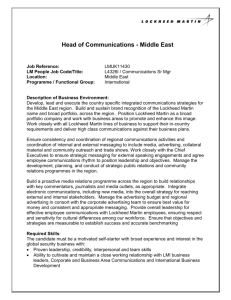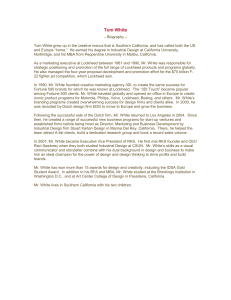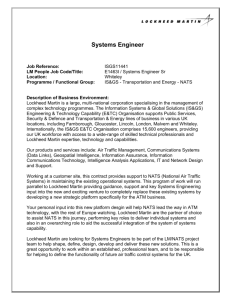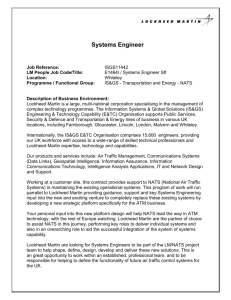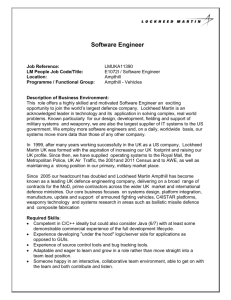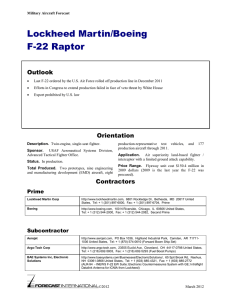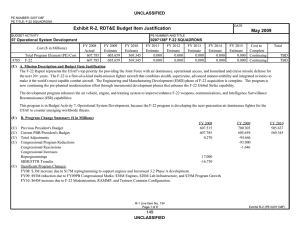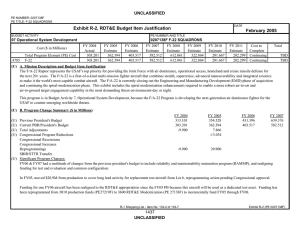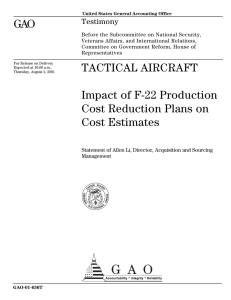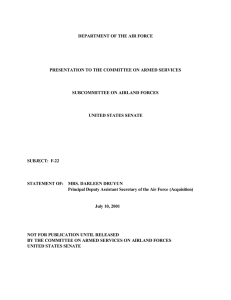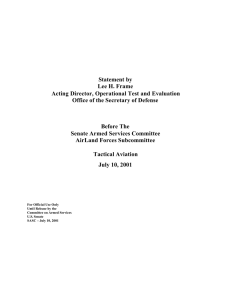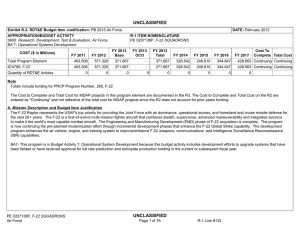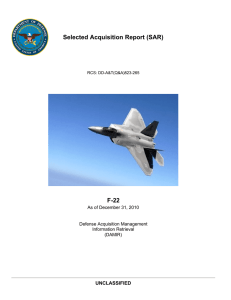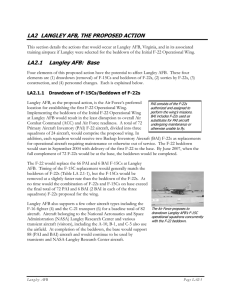more like 35000
advertisement
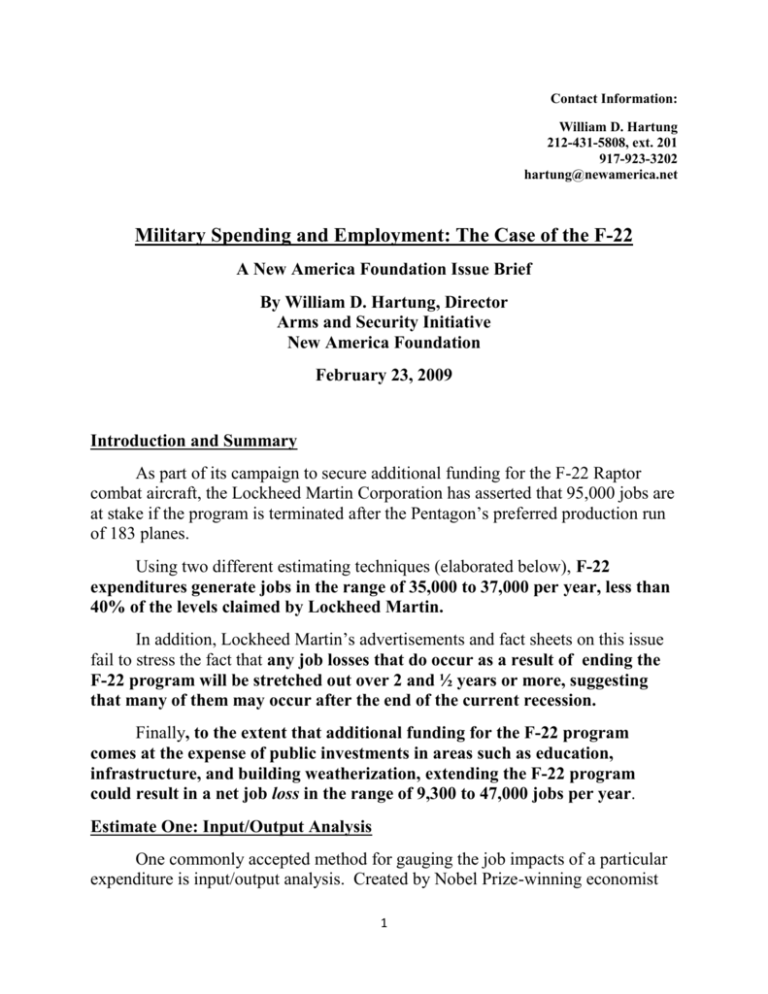
Contact Information: William D. Hartung 212-431-5808, ext. 201 917-923-3202 hartung@newamerica.net Military Spending and Employment: The Case of the F-22 A New America Foundation Issue Brief By William D. Hartung, Director Arms and Security Initiative New America Foundation February 23, 2009 Introduction and Summary As part of its campaign to secure additional funding for the F-22 Raptor combat aircraft, the Lockheed Martin Corporation has asserted that 95,000 jobs are at stake if the program is terminated after the Pentagon’s preferred production run of 183 planes. Using two different estimating techniques (elaborated below), F-22 expenditures generate jobs in the range of 35,000 to 37,000 per year, less than 40% of the levels claimed by Lockheed Martin. In addition, Lockheed Martin’s advertisements and fact sheets on this issue fail to stress the fact that any job losses that do occur as a result of ending the F-22 program will be stretched out over 2 and ½ years or more, suggesting that many of them may occur after the end of the current recession. Finally, to the extent that additional funding for the F-22 program comes at the expense of public investments in areas such as education, infrastructure, and building weatherization, extending the F-22 program could result in a net job loss in the range of 9,300 to 47,000 jobs per year. Estimate One: Input/Output Analysis One commonly accepted method for gauging the job impacts of a particular expenditure is input/output analysis. Created by Nobel Prize-winning economist 1 Wassily Leontief in the 1960s and refined since that time, input/output analysis tracks the distribution of a given form of spending as it makes its way through different sectors of the economy. Input/output analysis estimates the job impacts of three different levels of spending: direct, indirect, and induced jobs. Each of these terms is defined below: 1) Direct employment: Jobs associated with the primary production and assembly of the product; 2) Indirect employment: Jobs associated with industries that supply “intermediate goods” such as metal, glass and rubber that are used to produce components of a given product; 3) Induced employment: Jobs created when people involved in production of the production of the product spend their paychecks on food, shelter, and other goods and services. According to a November 2007 report by two economists at the University of Massachusetts, military spending creates 8,555 jobs per $1 billion spent.i Figures from the most recent Pentagon document on program acquisition costs by weapons systems indicate that average expenditures for the F-22 over the past three years have averaged $4.2 billion per year.ii At that expenditure level, the total jobs sustained by the program would be 37,317 – including direct production work, work at subcontractors, and employment impacts of wages spent by F-22 workers. That is a far cry from the 95,000 figure that Lockheed Martin is using in its lobbying campaign for the aircraft. A Second Estimate: F-22 as Percentage of Total Lockheed Employment, plus a “Multiplier Effect” A second, somewhat rougher way to estimate the employment impacts of the F-22 is to look at its proportion of Lockheed Martin’s total revenue, and assign it a similar proportion of the company’s total employment. This direct employment is then multiplied by a multiplier of 2.5, consistent with the U.S. Department of Labor’s estimate of the ripple effect of direct employment in supporting other jobs throughout the economy. Using this approach, the $4.2 billion in average annual revenues generated by the F-22 accounts for 10% of the company’s $41.9 billion in total revenues for 2007, the most recent year for which full statistics are available. If this proportion holds true for employment as well, that would put the number of direct jobs attributable to the F-22 is 14,000 (ten per cent of the company’s total employment 2 of 140,000).iii Increasing this 14,000 via the Labor Department’s “multiplier effect” of 2.5 results in a total jobs estimate of 35,000, a figure similar to the estimate derived from the input/output estimate cited above. Where Does Lockheed Martin’s Estimate of 95,000 Jobs Come From? The origin of Lockheed Martin’s estimate of 95,000 total jobs related to the F-22 program can ultimately only be explained by the company itself. But one possible explanation is that the company has counted both direct jobs (at the prime contractor level) and indirect jobs (at the subcontractor level) as if they were the same in terms of their employment “ripple effect.” In fact, only direct jobs should be counted before applying the multiplier of 2.5 to come up with a final employment estimate. Employment Impacts Will Be Phased in Over Time Even if the Pentagon doesn’t spend another dime on F-22 production, the assembly line is expected to stay open for more than two and one-half years, until December 2011. This means that a significant part of any employment impact will not occur immediately, as some observers may have assumed. Rather there will be a sort of “rolling impact,” as suppliers of long-lead time items like titanium, rubber, and glass feel the pinch first, followed by producers of more sophisticated components, and then finally by those working on the final assembly of the aircraft. Hopefully by December 2011 the current economic downturn will have reversed itself, and the economy will be better equipped to absorb what in the larger employment picture is a fairly small effect (e.g., 10,000 jobs represents less than one one-hundredth of one percent of the total U.S. labor force of over 154 million).iv Opportunity Costs While it is hard to make comparisons in a turbulent budget environment marked by sharp increases in spending in some areas (via the stimulus package) and potential cuts in others (in keeping with President Obama’s pledge to get the budget deficit under control within the next four years), it is interesting to note that military spending creates far fewer jobs (8,555 per $1 billion) than any other form of public investment, be it health care (12,883), education (17,687), mass transit (19,795), or infrastructure/home weatherization (12,804). Similarly, a tax cut devoted to personal consumption would generate 10,779 jobs, over 25% per billion more than would be created by military spending. Assuming that the $4.2 billion currently spent on the F-22 were devoted to other purposes, there could be a net job increase of 9,340 (from tax cuts) to 47,208 (for mass transit).v 3 NOTES i For a description of input/output analysis, plus comparative numbers on the number of jobs per billion dollars generated by different activities, see Robert Pollin and Heidi Garrett-Peltier, “The U.S. Employment Effects of Military and Domestic Spending Priorities,” University of Massachusetts and the Institute for Policy Studies, October 2007 at http://www.ips-dc.org/reports/071001-jobcreation.pdf. ii U.S. Department of Defense, “Program Acquisition Costs by Weapons System,” FY 2008 edition, at http://www.defenselink.mil/comptroller/Docs/fy2008_weabook.pdf. iii For the most recent available figures on revenues and employment for Lockheed Martin, see the company’s 2007 annual report, at http://www.lockheedmartin.com/data/assets/corporate/documents/ir/2007-Annual-Report.pdf. iv On the size of the U.S. labor force, “Employment Situation Summary,” January 2009, at http://www.bls.gov/news.release/empsit.nr0.htm. v On job comparisons, see Pollin and Garrett-Peltier, op. cit., note 1. 4
